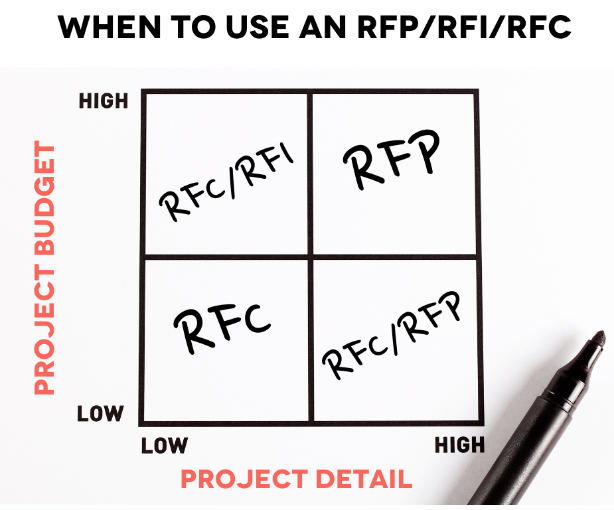
As a nonprofit, you are always looking for ways to get more bang for your buck. When it comes to finding a vendor, you want to make sure you are getting the best possible service for your money. One way to do this is to issue a Request for Proposal (RFP), Request for Information (RFI) or Request for Conversation (RFC). But which one is right for your needs?

A Request for Proposal (RFP) is usually issued when you have a specific project in mind and you want vendors to bid on the work. This is helpful if you know exactly what you need and you want to compare prices from different vendors.
A Request for Information (RFI) is similar to an RFP, but it is less specific. You may not have a specific project in mind, but you want to gather information about what vendors can offer. This can be helpful if you are trying to figure out what options are available to you.
A Request for Conversation (RFC) is the least formal of the three options. It is simply a way to start a conversation with potential vendors. This can be helpful if you are not sure what you need or if you just want to get an idea of what is out there.
When should a nonprofit use an RFP?
An RFP should be used when a nonprofit has a specific project or service in mind and wants to compare prices from different vendors. If a project is large or complex, an RFP may be the best option to ensure that all vendors are bidding on the same scope of work. Note that the process of creating a good RFP can take time and a base level of technical expertise, it is a lot easier to work from an RFP template designed for nonprofit organizations.
There are several benefits to using an RFP, including:
- Ensuring that all vendors are bidding on the same scope of work
- Comparing prices from different vendors
- Getting more detailed proposals from vendors
- Creating a competitive environment that can result in lower prices
Some tips for writing a successful RFP include:
- Defining the scope of work in detail
- Asking for specific information from vendors
- Giving vendors enough time to prepare their proposals
- Making sure that all stakeholders are involved in the RFP process
- Consider using an RFP generator to create a first draft.
Downsides to RFPs
- It takes time and sometimes technical expertise to create a good RFP
- RFPs can risk limiting the creative options that different vendors may have to the organization’s problems. (IE we must use this tech to solve this problem vs. we need to solve this problem).
- Many smaller companies and consultants refuse to go through RFP processes because they can be a waste of time. This will limit the potential pool of applicants usually to higher cost organizations that can afford the time it takes to create competitive proposals.
- Proposals for certain RFPs may actually be 90% template and not customized. Ironically a lot more could be learned from a shorter conversation compared to a 10 page proposal.
When should a nonprofit use a Request for Information (RFI)?
An RFI can be issued when a nonprofit wants to learn more about what is available in the marketplace or they want to better understand their options before issuing an RFP. This could be helpful when exploring new technology or software solutions. By sending out an RFI, nonprofits can get an idea of what vendors are available and what they would recommend.
There are several benefits to using an RFI, including:
- Learning more about what is available in the marketplace
- Getting vendor recommendations
- The process can quickly identify potential vendors for an RFP
- RFI conversations may reveal multiple solutions to problems and help improve the quality of the RFP process
Some tips for writing a successful RFI include:
- Defining the scope of work in detail
- Asking for specific information from vendors
- Making sure that all stakeholders are involved in the RFI process
Downsides to RFIs
- RFIs will usually extend the procurement process because the next step is usually a formal RFP and proposal from vendors.
- This formal process may scare off smaller vendors and consultants which will lead to a higher array of bids for the work. This can be mitigated by the verbiage of the RFI.
- It takes time to arrange conversations and aggregate data from RFIs.
When should a nonprofit use a Request for Conversation (RFC)?
A Request for Conversation (RFC) is just what it sounds like – it’s a request for vendors to come and talk with you about your project. This is helpful if you want to build relationships with potential vendors or if you are not sure what you need yet. An RFC can also help you understand the capabilities of different vendors and see how they would approach your project.
There are several benefits to using an RFC, including:
- Learning more about vendors’ capabilities quickly.
- Discussing the project in more detail can lead to better understanding of solutions and cost ranges.
- Establishing relationships with potential vendors and opening up the process to smaller organizations or consultants.
Some tips for writing a successful RFC include:
- Defining the general scope of work and problem that needs to be solved
- Asking for specific information from vendors
- Making sure that all stakeholders are involved in the RFC process
Downsides to RFC
- If the criteria of for vendors is too broad, this could lead to many weeks of conversations which takes time.
- If the project or problem is too undefined it will also waste time as vendors have to ask too many questions to get to the underlying project.
- The next step for a proposal, following conversation, or contract might be vague leading to a prolonged procurement process.
- Bias against non-native english speakers might cause organizations might impact the procurement process.
And when in doubt…
No matter which option you choose, issuing an RFP, RFI or RFC can help ensure that you are getting the best possible service for your money. It is our recommendation at Whole Whale that nonprofits with smaller budgets start with the Request for Conversation to better understand the ways a consultant might approach a problem. This can also help save your, and the consultant’s time which everyone appreciates!
Listen to Nonprofit.ist founder Heather Yandow discuss this topic on the Using the Whole Whale podcast.
Join Nonprofist.ist as a nonprofit member today to start searching for a consultant and begin the conversation!
Looking for more resources? Read Nonprofit.ist's article about why RFPs are the worst.
NONPROFITS: Are you looking for help?
Sign up for your
FREE nonprofit membership today.
EXPERTS: Are you looking for the right work?
Join the Nonprofit.ist network to
connect with people searching for you.